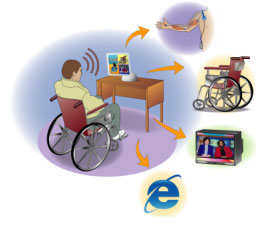The BrainGate device
attempts to translate movement-related thoughts into
environment-controlling actions in individuals with high-level injuries.
About four millimeters in size (~ the size of a baby aspirin), the
device’s sensor is composed of an array of hair-size electrodes and
implanted in the brain area responsible for movement. This device
transmits thought-stimulated, movement-associated neuronal signals
through the skull to a computer for analysis and processing. This, in
turn, is translated into user-controlled actions mediated through
electronic dev ices,
such as a computer cursor, a remote control, limb-controlling neural
prostheses, etc. Although the overall concept of thought-controlled
movement is not new, with ever-growing technical sophistication over
time, the development of real-world applications is becoming an
increasing reality.
ices,
such as a computer cursor, a remote control, limb-controlling neural
prostheses, etc. Although the overall concept of thought-controlled
movement is not new, with ever-growing technical sophistication over
time, the development of real-world applications is becoming an
increasing reality.
The current version of
the device is the subject of a National Institutes of Health (NIH)
sponsored study, which intends to implant the sensor device into the
motor cortex of 15 individuals with tetraplegia caused by a variety of
neurological causes, including SCI.
TOP